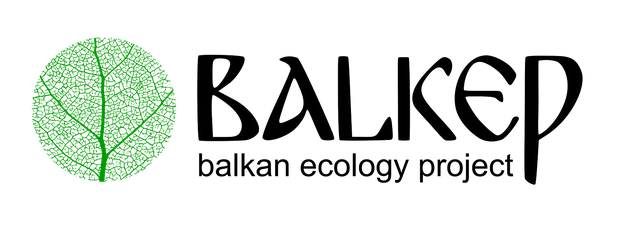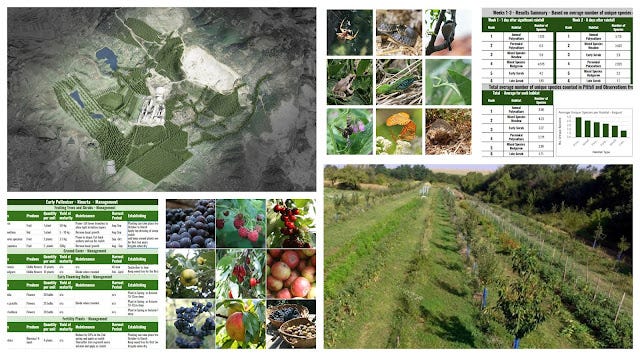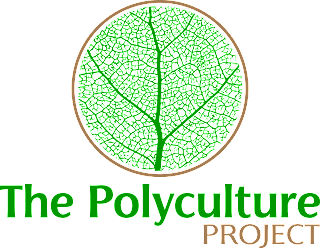Welcome to part 8 of a series where I'll share some observations and experiences about the various plant species from our forest gardens and regenerative landscapes, as well as interesting plants and polycultures from around the world. We'll be featuring plants from different layers of the forest garden, looking at some of the vital wildlife you can expect to find in a regenerative landscape and presenting some established polycultures as well as providing some suggestions about how to design, build and manage forest gardens and regenerative landscapes.
Forest Garden Plants
Shrub Layer - Ephedra distachya - Sea Grape is a unique plant suitable for dry and hot gardens but also tolerating the cold. This hardy plant can thrive in various soil types and environmental conditions, growing well in poor, rocky, or sandy soils and is resistant to drought, making it suitable for gardens with challenging growing conditions.
The fruits of all species in this genus are edible and taste pretty good , similar taste, texture and look as Yew - Taxus baccata fruit. The berries will attract wildlife to the garden, such as birds providing additional ecological benefits. The dense branching of the plant is also likely offer shelter for small animals and wide range of invertebrates
It thrives in sandy soils, making it an ideal choice for erosion control on slopes or in areas prone to soil erosion. Notably unfazed by strong maritime winds, I observed this resilience during my travels to the Absheron Peninsula in Azerbaijan, where vast stretches of the plant effortlessly bind the banks of the Sha spit that extends into the Caspian Sea.
There is a plant that was used in Zoroastrian worship referred to as haoma. This plant was considered a gift from Ahura Mazda and is described in the Avesta, the holy texts of Zoroastrianism. Consumption of the plant would provide strength, wisdom, health and ecstatic state of consciousness.
The identity of the haoma plant is not certain but some scholars believe that it was a species of ephedra, that contains the stimulant ephedrine and is commonly found in the wild around Iran and Azerbaijan where surviving Zoroastrian temples can be found.
Herb Layer - Alliaria petiolata - Garlic mustard and Lunaria annua - Honesty are two of my favorite spring self seeding annuals in the Forest Garden. Both edible, both attractive to borgs, both reliable.
Lunaria annua - Honesty leaves can be collected and used as a green vegetable or in salads before the flowers appear.. The flowers can be added to salads. The seeds can be used to make a mustard substitute which is strengthened by crushing and mixing with cold water and even the root can be peeled and eaten.
The plants will wither and dry out by early summer and I’ll collect up the stems with the seed heads and scatter them around new areas of the garden among the existing herb layer. A few will come up the following year and then spread naturally over the following seasons. They grow well in shady areas too as the flowering takes place in early April before the majority of trees have fully come out into leaf.
Alliaria petiolata - Garlic mustard is also encouraged to spread around the garden. This is biennial plant, a member of Brassicaceae, is native to Europe, Asia, and North Africa and makes a great spring ground cover where the soil has been left bare over winter. The fresh young leaves are edible and have a strong mustard flavor and the flowers are also extremely attractive to a range of solitary bees.
Ground Layer - Here’s a polyculture we are growing for ground cover where the crowns of a mature Cherry, Apple and Mulberry meet and probably receives no more than 4 hrs. of direct sunlight per day but plenty of dappled shade.
Included is a native ground cover of Ficaria verna - Lesser celandine, a creeping perennial from Ranunculaceae that flowers very early in the season providing nectar and pollen to the first pollinators that venture out in late winter. The plant has been consumed for food for centuries although it must be cooked to destroy the protoanemonin toxins.
Early flowering bulbs Muscari neglectum- Grape Hyacinth and Crocus vernus along with along with Alliums planted at different depths, play a vital role in spring. Their roots act as a filter, capturing minerals from spring rains before they leach deeper. These minerals are stored in the bulb tissues and then released back into the topsoil when the plants die back. This process, called nutrient cycling, helps maintain soil fertility for other plants in the garden.
Nectaroscordum siculum - Bulgarian Honey Garlic will start to flower in May and is one of the most spectacular floral displays this time of year. The plant is used to make a unique Bulgarian seasoning called Samardala. I’ve included a recipe for Samardala at the end of this post.
More on our forest garden plants here and fruit and nut cultivars we grow here
Regenerative Landscape Design - Online Interactive Course
Want to learn how to design, build and manage regenerative landscapes? Join us on our Regenerative Landscape Design - Online Interactive Course. We look forward to providing you with the confidence, inspiration, and opportunity to design, build and manage regenerative landscapes, gardens, and farms that produce food and other resources for humans while enhancing biodiversity.
You can find the course details here and at the moment we have a $350 ( 20%) discount for full enrollment to the course. Just use RLD2024 in the promo code section of the registration form to receive your discount.
Wildlife
Incredible diversity of invertebrates on our Japanese Pepper Tree - Zanthoxylum piperitum trees that have just started to blossom.






The fruits will ripen in early October and deliver a unique flavor experience that goes beyond just spiciness. Unlike black pepper that hits you with heat, Sansho (the Japanese name for Zanthoxylum piperitum) creates a tingling, numbing sensation on the tongue. Some describe it as a kind of electric buzz!
These plants are often referred to as being dioecious however I have grown these plants from seed and grown them as single specimens in various gardens and they have all produced flowers and fruits within 5-7 years. Perhaps some Zanthoxylum species are dioecious but certainly not Z.piperitum.
Plant Profile here
Welcome to our Online Store where you can find Forest Garden/ Permaculture plants, seeds, bulbs and Polyculture multi-packs along with digital goods and services such as Online Courses, Webinars and eBooks. We hope you enjoy the store and find something you like.
It's your purchases that keep our Project going! Enter Our Store Here
Polycultures Around the World - Turkish Riviera - Muğla Province
The majority of gardens in the towns on and around the Turkish Riviera are great examples of Forest Gardens packing multiple layers of productive plants in concentrated areas including herbs and climbers
It's uncommon to see a garden that does not have at least a few Fig, Mulberry, Grapevine, Citrus, Olive, Loquat, Pomegranate and many gardens have all of these plants and many more
Plant Profiles for Fruiting Plants suitable for Mediterranean Forest Gardens
More plants for Forest Gardens here
Recipes - Samardala
Nectaroscordum siculum - Bulgarian Honey Garlic is a unique plant native to the Balkan Peninsula. Its fragrant leaves are used to make Samardala, a traditional Bulgarian condiment with a pungent garlicky taste. Here are the instructions to create this flavorful seasoning.

Ingredients:
Nectaroscordum siculum leaves (freshly harvested)
Sea salt
Instructions:
Harvest the leaves: The ideal time to harvest the leaves for Samardala is in early spring when they are young and tender and before the inflorescence (scape) develops
Wash and dry: Gently wash the leaves to remove any dirt or debris. Pat them dry with a clean cloth or paper towel.
Chop finely: Finely chop the leaves. You can use a sharp knife or a food processor for this step.
Mix with salt: In a bowl, combine the chopped leaves with a generous amount of sea salt. The exact amount of salt will depend on your preference, but a good starting point is a 1:1 ratio of leaves to salt by volume.
Massage the mixture: Using your hands, massage the salt into the leaves for a few minutes. This process helps break down the plant cell walls and release the flavors.
Drying: Spread the salted leaf mixture on a clean drying tray or plate in a single layer. Choose a well-ventilated location with good air circulation and indirect sunlight.
Monitor and stir: Stir the mixture occasionally to ensure even drying. Depending on the humidity and air circulation, drying can take several days to a week.
Storage: Once the Samardala is completely dry, store it in an airtight container in a cool, dark place. This will help preserve its flavor and aroma.
Tips:
You can wear gloves while handling the leaves to avoid any skin irritation.
If you prefer a finer Samardala, you can grind the dried mixture once it's completely dry using a mortar and pestle or a spice grinder.
Samardala adds a unique and slightly garlicky flavor to various dishes. Experiment and use it in stews, soups, dips, or sprinkled on vegetables and meats.
Enjoy your homemade Samardala!
Support Our Project
If you appreciate the work we are doing you can show your support in several ways.
Become a member of the Bloom Room. A $70 annual subscription to our Substack provides you with access to live sessions, design tutorials, a members forum and more, see details here.
Make a purchase of plants or seeds from our Nursery or Online Store
Joining us for one of our Practical Courses or Online Courses
Comment, like, and share our content on social media.
Want to learn more about Regenerative Landscape Design? Join The Bloom Room!
The Bloom Room is designed to create a space for more in-depth learning, for sharing projects and ideas, for seeking advice and discovering opportunities.
Ultimately, it aims to build a more intimate, interactive, and actionable relationship between members, a way for the Bloom Room community to support each other’s projects and learning journeys, and to encourage and facilitate the design, build, and management of more regenerative landscapes across our planet.
What you can expect as a member of the Bloom Room
As a member of the Bloom Room you can expect;
Access to an interactive forum where you can ask questions, direct what type of content you would like to see as well as share your own content and projects.
Monthly live session featuring general Q&A and tutorials on design software for creating and presenting polycultures.
Live session every month for members to showcase your projects, plans, designs, and gardens, with guest speakers from the community.
Full Access to all of the content on Substack
A 50% discounts on all of our online courses
Future opportunities to join our Global Regenerative Landscape Design and Consultancy Service, with potential roles for those with the will and skill to join our design team.
An opportunity to take part in the group ownership of a Regenerative Landscape. You will find more details on that here.
Become a paid subscriber to our Substack to join. The annual subscription is currently $70 and the monthly subscription is $7 (monthly subscription excludes discounts for products and services) . You can join here, we look forward to meeting you!
We offer a diversity of plants and seeds for permaculture, forest gardens, and regenerative landscapes including a range of fruit and nut cultivars. We Deliver all over Europe from Nov - March. - Give a happy plant a happy home :)


















